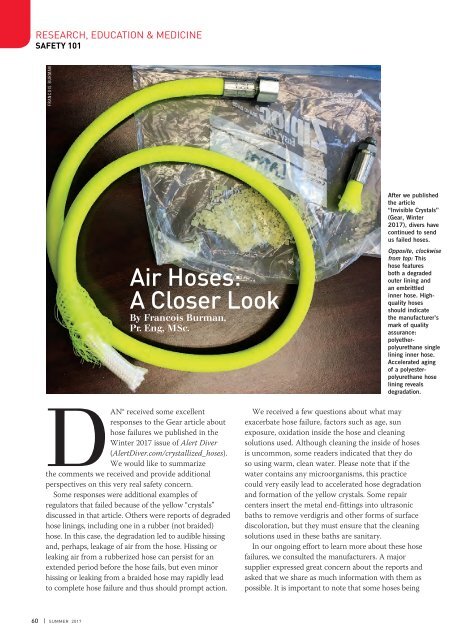AD 2017 Q3
Alert Diver is the dive industry’s leading publication. Featuring DAN’s core content of dive safety, research, education and medical information, each issue is a must-read reference, archived and shared by passionate scuba enthusiasts. In addition, Alert Diver showcases fascinating dive destinations and marine environmental topics through images from the world’s greatest underwater photographers and stories from the most experienced and eloquent dive journalists in the business.
Alert Diver is the dive industry’s leading publication. Featuring DAN’s core content of dive safety, research, education and medical information, each issue is a must-read reference, archived and shared by passionate scuba enthusiasts. In addition, Alert Diver showcases fascinating dive destinations and marine environmental topics through images from the world’s greatest underwater photographers and stories from the most experienced and eloquent dive journalists in the business.
Create successful ePaper yourself
Turn your PDF publications into a flip-book with our unique Google optimized e-Paper software.
RESEARCH, EDUCATION & MEDICINE<br />
SAFETY 101<br />
FRANCOIS BURMAN<br />
Air Hoses:<br />
A Closer Look<br />
By Francois Burman,<br />
Pr. Eng, MSc.<br />
After we published<br />
the article<br />
“Invisible Crystals”<br />
(Gear, Winter<br />
<strong>2017</strong>), divers have<br />
continued to send<br />
us failed hoses.<br />
Opposite, clockwise<br />
from top: This<br />
hose features<br />
both a degraded<br />
outer lining and<br />
an embrittled<br />
inner hose. Highquality<br />
hoses<br />
should indicate<br />
the manufacturer’s<br />
mark of quality<br />
assurance:<br />
polyetherpolyurethane<br />
single<br />
lining inner hose.<br />
Accelerated aging<br />
of a polyesterpolyurethane<br />
hose<br />
lining reveals<br />
degradation.<br />
DAN® received some excellent<br />
responses to the Gear article about<br />
hose failures we published in the<br />
Winter <strong>2017</strong> issue of Alert Diver<br />
(AlertDiver.com/crystallized_hoses).<br />
We would like to summarize<br />
the comments we received and provide additional<br />
perspectives on this very real safety concern.<br />
Some responses were additional examples of<br />
regulators that failed because of the yellow “crystals”<br />
discussed in that article. Others were reports of degraded<br />
hose linings, including one in a rubber (not braided)<br />
hose. In this case, the degradation led to audible hissing<br />
and, perhaps, leakage of air from the hose. Hissing or<br />
leaking air from a rubberized hose can persist for an<br />
extended period before the hose fails, but even minor<br />
hissing or leaking from a braided hose may rapidly lead<br />
to complete hose failure and thus should prompt action.<br />
We received a few questions about what may<br />
exacerbate hose failure, factors such as age, sun<br />
exposure, oxidation inside the hose and cleaning<br />
solutions used. Although cleaning the inside of hoses<br />
is uncommon, some readers indicated that they do<br />
so using warm, clean water. Please note that if the<br />
water contains any microorganisms, this practice<br />
could very easily lead to accelerated hose degradation<br />
and formation of the yellow crystals. Some repair<br />
centers insert the metal end-fittings into ultrasonic<br />
baths to remove verdigris and other forms of surface<br />
discoloration, but they must ensure that the cleaning<br />
solutions used in these baths are sanitary.<br />
In our ongoing effort to learn more about these hose<br />
failures, we consulted the manufacturers. A major<br />
supplier expressed great concern about the reports and<br />
asked that we share as much information with them as<br />
possible. It is important to note that some hoses being<br />
60 | SUMMER <strong>2017</strong>









